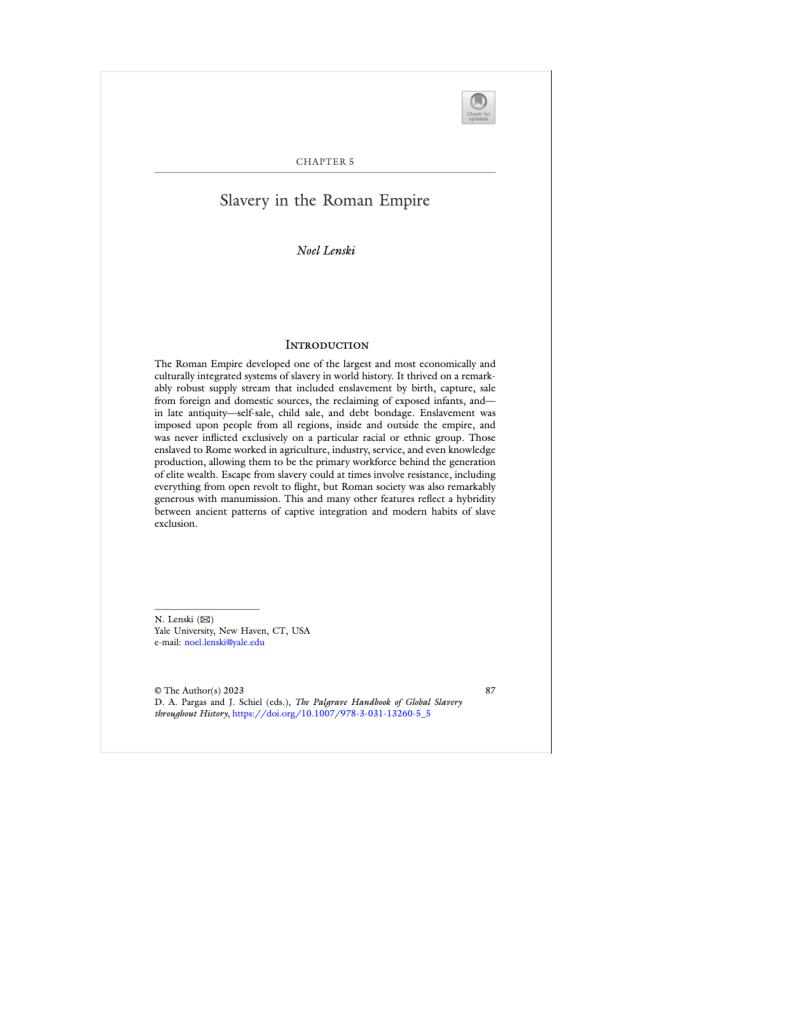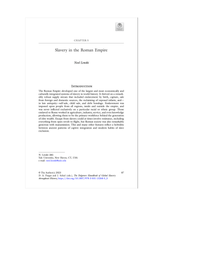Historian Noel Lenski describes Roman slavery.
- Type
- Book
- Source
- Noel Lenski Non-LDS
- Hearsay
- Secondary
- Reference
Noel Lenski, "Chapter 5: Slavery in the Roman Empire," The Palgrave Handbook of Global Slavery throughout History ed. Damian Pargras and Juliane Schiel (Palgrave MacMillan: Cham, Switzerland, 2023) 87-107
- Scribe/Publisher
- Palgrave MacMillan
- People
- Noel Lenski
- Audience
- Reading Public
- Transcription
Introduction
The Roman Empire developed one of the largest and most economically and culturally integrated systems of slavery in world history. It thrived on a remarkably robust supply stream that included enslavement by birth, capture, sale from foreign and domestic sources, the reclaiming of exposed infants, and—in late antiquity—self-sale, child sale, and debt bondage. Enslavement was imposed upon people from all regions, inside and outside the empire, and was never inflicted exclusively on a particular racial or ethnic group. Those enslaved to Rome worked in agriculture, industry, service, and even knowledge production, allowing them to be the primary workforce behind the generation of elite wealth. Escape from slavery could at times involve resistance, including everything from open revolt to flight, but Roman society was also remarkably generous with manumission. This and many other features reflect a hybridity between ancient patterns of captive integration and modern habits of slave exclusion. Roman slaving was practiced in a Mediterranean context where captive taking and slaveholding were nearly universal. From the Semitic and Greek peoples that populated the East, to the Germanic and Celtic peoples in the North and West, to the Phoenicians, Africans, and Egyptians in the South, slaving was an ancient and entrenched tradition before, during, and after the flourishing of the Roman Empire between the third century BCE and the fifth CE. Aware of this, the Romans enshrined it in the legal principles by which they structured their own practices. When Roman jurists described the legal basis on which an individual might enter slavery, they did so with reference to a bipartite division between the “law of all peoples” (ius gentium) and their own “civil law” (ius civile). The former included two of the most common ways to enter servile status, birth to a slave and captivity to the Romans in enemy combat. For the Romans, birth into slave status depended entirely on one’s mother, for the Romans followed the principle of partus ventrem sequitur (offspring follow the womb): an enslaved mother bore children who were slaves, while a free woman birthed free children, regardless of the status of the father. We have no quantifiable data to help us determine the relative importance of various channels into the Roman slave supply stream, but modern historians agree that birth was the biggest.
Nevertheless, captivity by all means played a crucial role in bolstering the enslaved population. Massive captive-taking events are recorded regularly in the sources, many of them so sizeable that they temporarily crashed prices on the slave market. This was largely a result of Rome’s repeated successes in large-scale combat against foreign enemies and the ruthless efficiency with which Roman armies disposed of enslaved persons into the market. Julius Caesar, one of Rome’s greatest conquerors, is said to have enslaved 1,000,000 Gauls in his sweeping campaigns in the territory of what is today France between 58 and 50 BCE; on a single day in 57 he sold 53,000 members of the Atuatuci tribe to slave dealers; and when he achieved victory at the Battle of Alesia in 52, he distributed one Gallic captive as plunder to each of his 80,000 soldiers.
...
The B. H. Roberts Foundation is not owned by, operated by, or affiliated with the Church of Jesus Christ of Latter-day Saints.



